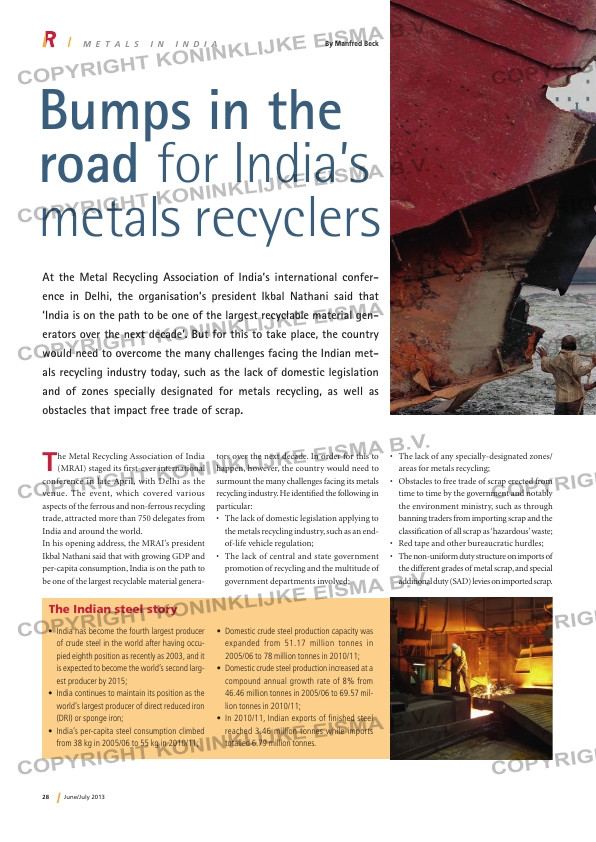28 June/July 2013
At the Metal Recycling Association of India’s international confer-
ence in Delhi, the organisation’s president Ikbal Nathani said that
‘India is on the path to be one of the largest recyclable material gen-
erators over the next decade’. But for this to take place, the country
would need to overcome the many challenges facing the Indian met-
als recycling industry today, such as the lack of domestic legislation
and of zones specially designated for metals recycling, as well as
obstacles that impact free trade of scrap.
The Metal Recycling Association of India (MRAI) staged its first-ever international
conference in late April, with Delhi as the
venue. The event, which covered various
aspects of the ferrous and non-ferrous recycling
trade, attracted more than 750 delegates from
India and around the world.
In his opening address, the MRAI’s president
Ikbal Nathani said that with growing GDP and
per-capita consumption, India is on the path to
be one of the largest recyclable material genera-
tors over the next decade. In order for this to
happen, however, the country would need to
surmount the many challenges facing its metals
recycling industry. He identified the following in
particular:
• The lack of domestic legislation applying to
the metals recycling industry, such as an end-
of-life vehicle regulation;
• The lack of central and state government
promotion of recycling and the multitude of
government departments involved;
M e t a l s i n i n d i a By Manfred Beck
Bumps in the
road for India’s
metals recyclers
• India has become the fourth largest producer
of crude steel in the world after having occu-
pied eighth position as recently as 2003, and it
is expected to become the world’s second larg-
est producer by 2015;
• India continues to maintain its position as the
world’s largest producer of direct reduced iron
(DRI) or sponge iron;
• India’s per-capita steel consumption climbed
from 38 kg in 2005/06 to 55 kg in 2010/11;
• Domestic crude steel production capacity was
expanded from 51.17 million tonnes in
2005/06 to 78 million tonnes in 2010/11;
• Domestic crude steel production increased at a
compound annual growth rate of 8% from
46.46 million tonnes in 2005/06 to 69.57 mil-
lion tonnes in 2010/11;
• In 2010/11, Indian exports of finished steel
reached 3.46 million tonnes while imports
totalled 6.79 million tonnes.
• The lack of any specially-designated zones/
areas for metals recycling;
• Obstacles to free trade of scrap erected from
time to time by the government and notably
the environment ministry, such as through
banning traders from importing scrap and the
classification of all scrap as ‘hazardous’ waste;
• Red tape and other bureaucratic hurdles;
• The non-uniform duty structure on imports of
the different grades of metal scrap, and special
additional duty (SAD) levies on imported scrap.
The Indian steel story
RI-5_MRAI.indd 28 17-06-13 15:16




